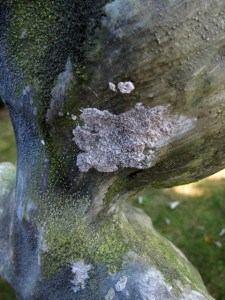
Adding texture and color variation is an excellent way to increase the visual interest of a prop or piece of artwork. Weathering a piece gives a sense of age and creepiness that adds to the overall atmosphere of a display. I have received many comments about the aging techniques I used on my “Pumpkin Baby” statue and would like to share a simple technique for adding moss and lichens to a prop.
Materials needed: Acrylic paint, water, play sand.
After the piece has been painted and has dried completely, mix up some acrylic paint and water to a very runny consistency. I don’t measure the proportions, but look for a thin mixture that will drip off of a thick paintbrush. Position your piece so that the area you want the lichens is laying horizontal. This is important to keep the paint from running and ruining the effect. Dip a thick paintbrush into the paint mixture, and from a distance of about 2 to 3 feet, allow the paint to drip down onto the piece, creating a nice random splatter pattern. Immediately sprinkle sand onto the drip. This will hold the dripped paint in place and create the lichen. You can add more paint drips over top of this area to make aging and growth heavier, or leave it alone for a sparse look.
It is important to remember that Nature is random in its growth patterns. Do not overthink the paint drips as you are applying them. This will lend a very artificial and planned look that will distract from the piece rather than adding to the effect.
After a lichen area had completely dried, you can change the coloring by dripping other colors of paint over the area and then misting with a spray bottle and some plain water.
Note: It is very important to be patient and allow each application to completely dry…If you speed this along you will simply wash away the lichen growth you just applied. Experiment with different ways to drip the paint and the sand. You will be amazed at how such a simple technique can give such great looking results.
